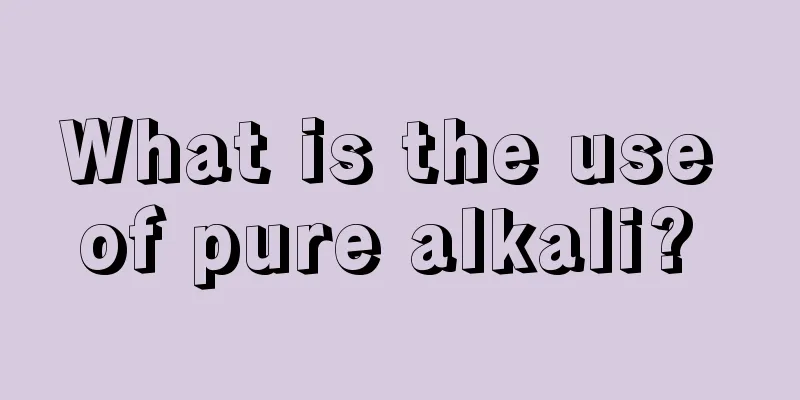What is the use of pure alkali?

|
Pure alkali is very common in industry. Many people often confuse pure alkali with edible alkali. Edible alkali and pure alkali are not the same thing. The sodium carbonate content in pure alkali is very high and it cannot be used for food. Due to its high concentration, pure alkali can seriously burn human skin. Everyone should pay attention that pure alkali must not be diluted by itself and consumed as edible alkali. So what can pure alkali be used for? What are the uses of pure alkali Industrial uses: 1. Used in the food industry as a neutralizer and leavening agent, such as in the manufacture of amino acids, soy sauce and flour-based foods such as steamed bread and bags. It can also be mixed into alkaline water and added to pasta to increase elasticity and ductility. 2. The glass industry is the largest consumer of pure alkali, with each ton of glass consuming 0.2 tons of pure alkali. It is often used to make water glass, sodium dichromate, sodium nitrate, sodium fluoride, baking soda, borax, trisodium phosphate, etc. 3. In the metallurgical industry, it is used as a smelting flux, a flotation agent for mineral processing, and a desulfurizer for steelmaking and antimony smelting. 4. In the leather industry, it is used for degreasing raw hides, neutralizing chrome tanned leather and increasing the alkalinity of chrome tanning liquid. 5. Used as a water softener in printing and dyeing industry. 6. Make soap by reacting fatty acids with pure alkali. 7. Pure alkali is also used in the production of refractory materials and glazes in the ceramic industry. 8. Used in the production of synthetic detergent additives such as sodium tripolyphosphate and other sodium phosphate salts. Uses in daily life: 1. To make dough. During the process of dough rising, microorganisms will produce acid, and the dough will become sour after rising. Alkali must be added to neutralize it in order to make delicious pasta. 2. Remove dirt. If there are too many tea stains on teapots or other tea-drinking utensils that are often used and are difficult to brush off, soak them in alkaline water and then it will be easy to brush off. Of course, you can also use it to brush things with a lot of grease. 3. Alkali has a strong degreasing effect and can remove excess oil from oil-soaked dry food ingredients. 4. When stir-frying beef, it is easy to overcook if you don't control the heat well. The meat will be fried dry and not tasty. That is because the fibers of beef are very small and it is not easy to retain moisture. Add a little alkali in it, stir evenly, then add starch and stir evenly. Then the moisture will not be easily lost when stir-frying, and the meat will remain very tender. 5. Alkali can neutralize the organic acids or sulfides that adhere to dark green vegetables due to excessive spraying of pesticides, thereby preserving the original color of the vegetables and removing the contamination of pesticides on the vegetables. 6. Alkali can release the niacin in corn that is difficult to release, so that people who eat corn for a long time will not suffer from pellagra due to the lack of niacin in corn. 7. Alkali can remove the rancid smell from oil. The method is to wait until the rancid oil is heated to a temperature that is hot to the touch, then add a certain amount of pure alkaline water and stir it slowly with chopsticks. 8. Alkali is hot in nature and bitter in taste. It has the effects of removing dampness and heat, resolving food stagnation, detoxifying and reducing acid. 9. If old towels become black and hard, you can put the towels and alkaline water in an enamel pot, boil them, and keep them warm for a few hours. The towels will then become clean and soft. 10. When charging and maintaining lead-acid batteries, you must always keep some pure alkali nearby in case of emergency contact with the acid. (Acid and alkali neutralization) The hazards of pure alkali Invasion routes: Health hazards: This product is irritating and corrosive. Direct contact may cause skin and eye burns. Inhalation of its dust and smoke during production can cause respiratory irritation and conjunctivitis, as well as nasal mucosal ulcers, atrophy and nasal septum perforation. Prolonged contact with this solution may cause eczema, dermatitis, corn-like ulcers and skin sagging. Workers exposed to this product have an increased incidence of respiratory diseases. Accidental ingestion may cause gastrointestinal burns, mucosal erosion, bleeding and shock. Environmental hazards: Explosion hazard: This product is non-flammable, corrosive and irritating, and can cause burns to the human body. |
<<: The efficacy and function of tea seed cake
>>: Comparison of side profile before and after dental surgery?
Recommend
How to treat liver problems with spots
The main function of the liver is to excrete toxi...
Is melanoma harmful to the human body?
The early symptoms of melanoma are not very obvio...
Can oranges really help sober you up
Today's living standards are constantly impro...
What are the differences between rhinitis and nasopharyngeal carcinoma and what are the folk remedies for treatment
What is the difference between rhinitis and nasop...
How to drink sparkling white wine
Sparkling wine is a type of wine, but because it ...
What happens if you put hot food in the refrigerator?
I believe everyone is familiar with the refrigera...
What causes pain in the soles of my feet?
Pain in the soles of your feet can come from seve...
What underwear to wear after mastectomy
With the increase of life and work pressure, the ...
It is a big mistake to wash fruits and vegetables with rice water
There are hundreds of cleaning methods circulatin...
What is the basis for diagnosing glioma
Many patients who are diagnosed with glioma feel ...
What should I do if I have pain in the middle of my spine when I wake up in the morning?
A normal spine is very important to people's ...
How long is the correct time to take a walk after a meal
Many friends think that taking a walk after a mea...
Can artificial abortion lead to cervical cancer? What are the common treatments for cervical cancer?
Cervical cancer is the most common gynecological ...
What are the wonderful uses of bee pollen
Bee pollen is essentially a kind of male reproduc...
How to check stomach problems
Nowadays, many young people suffer from stomach p...









